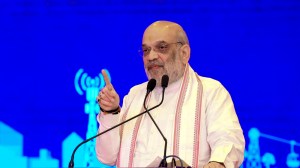The Power Factor
Jyoti Basus constituency voted out left long before the rest of Bengal did
A strong wind blowing through Umaidpur,West Bengal,shakes the kerosene lamp,disturbing Abhijit Das,8,at his homework. When it eventually puts out the flame,the Class I pupil of Golbari Primary School waits for his mother to light it once again.
Umaidpur is a village without electricity in Satgachia,the constituency that used to elect former chief minister Jyoti Basu. Many of the 108 mouzas that made up Basus constituency of 24 years delimitation has changed its contours since are still without electricity. And it is just 32 km from Kolkata.
One should have been proud to say they lived in the CMs constituency, says Karuna Das,Abhijits mother,indicating she was not. Had it been any other leader,we could have approached him. But Jyotibabu was hardly accessible. He used to come once before an election,would address a rally and after that he wouldnt be seen again.
Long before Bengal voted out the Left,Satgachia had started showing some of the first signs. Basus victory margin dwindled over the years,from 38,000 in 1977 to 27,000 the next time and finally 10,000 in 1996,the last time he contested an election.
In 2001,the Trinamool Congress wrested the seat. Sonali Guha defeated the CPM candidate by 6,000 votes,having campaigned on the plank of underdevelopment.
Basus uninterrupted term was not without tangible instances of development,such as a college at Burrul,a few Madhyamik and primary schools,a water treatment plant,computers to a few schools,ambulances. But voters in the Chief Ministers constituency had expected industry and an engineering or medical college. They did not get even a government hospital.
It was our bad luck that our representative was Jyoti Basu. Development should have begun at home but Jyoti Basu did nothing for us. Our area gets waterlogged every monsoon,with the government never completing a project to restore the Suti canal that runs through our village, says Shaikh Israel of Chak Kashipur village.
He says they used to struggle for water and it is only thanks to the Trinamool MLA that they now have taps. Some roads too have been relaid,he adds.
The one hospital Satgachia did get in Basus time,a super-specialty one run by the Birlas,has since been downsized. So have other units,such as a huge industrial park called Birlapur and a dairy farm.
When opened in 1989,the super-specialty hospital with 60 beds and an operation theatre was described as one that could match the best in the country. A bed cost just Rs 35 per day and most medical tests were done there. But the in-patients section was closed down in 1998 after a gynaecologist was stabbed outside the hospital. The out-patients section does continue,with people getting treatment for Rs 10.
A jute mill and two other factories are all else the constituency can boast today.
Once the area used to bristle with thousands of people but now it looks deserted. Instead of bringing new industries Basu presided over the destruction of industry in his own area, a resident says.
The local CPM defends Basu and blames the people for lack of development. It will not be correct to say Basu did nothing here. We provided drinking water to every household. Electrification was done massively but some villages might have remained out of the drive. We took up schemes like ICDES. But we could have done more had our own leaders and ministers been more active. What could Jyoti Basu do alone? says Gokul Bairagi,Basus poll agent,who contested the seat in 2001 and lost.
Photos





- 01
- 02
- 03
- 04
- 05


























